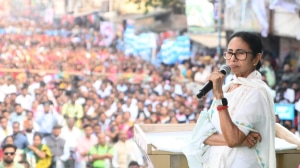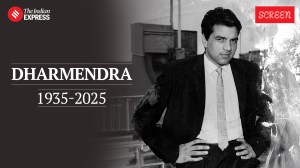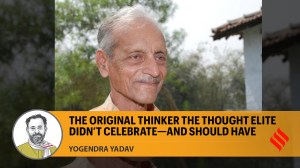When officials pressed Jayalalithaa to attend 1992 Mahamaham festival, which ended in stampede that killed 48
Former Tamil Nadu top cop says in autobiography that the ex-CM was reluctant since ‘it would put a heavy strain on the police’
 Speaking to The Indian Express Tuesday, Devaram said Jayalalithaa was upset after hearing the news and had apologised for the deaths.
Speaking to The Indian Express Tuesday, Devaram said Jayalalithaa was upset after hearing the news and had apologised for the deaths.Former Tamil Nadu top cop Walter Isaac Devaram has said in his autobiography that it was after the insistence of bureaucrats and police officers, including Devaram himself, that J Jayalalithaa attended the 1992 Mahamaham festival in Kumbakonam. The event had ended in a stampede in which 48 people were killed.
The tragedy had been a significant political setback for Jayalalithaa, who was in her first stint as chief minister at the time. Most of the blame for the incident fell on Jayalalithaa and her close aide V K Sasikala, with many alleging that their presence at the spot had led to the tragedy as the administration focused on them instead of the crowd.
It had sparked a widespread public outcry, with Jayalalithaa’s administration facing allegations of inefficiency and insensitivity.
Devaram, the then additional director general of police in charge of law and order, coordinated the security arrangements for the event. In his autobiography, Munnar to Marina, The Journey, he describes the lead-up to the incident: “When the Mahamaham came up for discussion at a meeting with her (Jayalalithaa), the Chief Secretary, the Home Secretary, the DGP, and other senior officers, including me, requested her to grace the occasion.”
“She was emphatic that she would not like to undertake the visit as it would put a heavy strain on the police. But all the officers pressed for her presence as the festival coincided with her birth star, ‘Maham’. Finally, she relented and agreed to reach the spot just before the auspicious time and leave immediately after the holy dip,” Devaram wrote.
After the tragedy, the state government faced criticism for inadequate crowd control and insufficient safety protocols.
According to Devaram’s account, organisers were expecting “a much larger influx of pilgrims than at the previous Mahamaham” and had planned accordingly. “Everything pointed to a more successful festival bandobast than the one in 1980,” Devaram wrote of the event that takes place once in 12 years.
A temporary helipad had been set up 3 km from a water tank where devotees take a holy dip on the occasion of the festival. Arrangements had been made to take Jayalalithaa and Sasikala straight from the helipad to the tank and back after the holy dip.
On the day, everything started smoothly, writes Devaram. The Mahamaham tank filled up hours before the auspicious time, and Devaram was in the police control room. The arrangement allowed pilgrims to enter from the east and west and exit from the north and south. “An hour before the auspicious time, I took up my position alongside the head priest on the southern bank, just as I had done in 1980. I was to fire a Very Pistol (flare gun) as soon as the head priest gave the nod, the flare announcing the auspicious moment to the pilgrims,” he wrote.
When the helicopter arrived, DGP Sripal received the CM Jayalalithaa and Sasikala. They were escorted to the tank, where a small area was cordoned off. 10 minutes before Zero Hour, they were guided down the steps. At the auspicious time, Devaram fired the flare gun and the crowd took three dips in the tank and moved to the exits, to be replaced by those who were awaiting their turn.
“This process was going on when the Chief Minister’s entourage left the tank, accompanied by the Chief Secretary and the DGP,” he wrote. “It was only a while after the Chief Minister had left the tank that I, on the southern bank, became aware of the tragedy that had taken place on the northern bank, which was the main exit point,” he said.
Several accounts from journalists at the time had blamed police for ignoring the deaths so as not to create panic in Jayalalitha’s presence. It was also alleged that they did not even remove the dead and the injured for almost half an hour after the stampede.
Devaram said the tragedy was caused by the “hasty descent of those waiting on the bank getting in the way of those leaving the tank”.
After initiating the rescue operations, Devaram said he radioed the DGP and informed him of the tragedy. “The helicopter was yet to take off (back to Chennai); but the DGP decided not to inform the Chief Minister of what had happened, knowing full well that she would insist on returning to the tank to convey her sympathy and supervise the relief operations. Such a move would only have created mayhem, resulting in more deaths… She was informed of the tragedy only after the helicopter reached Madras…”
Devaram wrote that Jayalalithaa did not punish any official over the incident. “Under similar circumstances, heads would have rolled, at least the DGP’s and mine; definitely mine, as I was in direct charge of the entire bandobast arrangements. But the Chief Minister, in all her magnanimity, instead of blaming the police as is often done, took the blame on herself, thereby pacifying the public, silencing the opposition, and moderating the press,” he wrote.
Speaking to The Indian Express Tuesday, Devaram said Jayalalithaa was upset after hearing the news and had apologised for the deaths. “At the event, she was in one corner… She and Sasikala took the dip and left immediately… Nobody was at fault. Everyone did their work. In spite of that, the tragedy happened,” said Devaram, 84.
He went on to become the DGP, and has been known for famous investigations, close encounters with LTTE leader Prabhakaran and forest brigand Veerappan. He has also faced allegations of extra-judicial acts.







